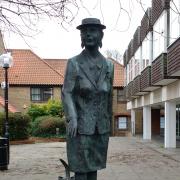Anne Knight was an inspiring young woman, born in Essex, who had a village named after her Words: Mica Bale
With a history of existence that dates back long before the Romans trod our streets, countless generations of Essex families have produced a long list of fascinating trailblazers, ranging from explorers and revolutionaries to inventors and show business stars. In amongst all these people lays the story of a woman whose simple personal principles led her to have an almost immeasurable impact on the lives of countless individuals. Her name was Anne Knight, an unassuming Essex girl with a big heart and a powerful energy.
Mention the name Anne Knight in Essex and it could be easily assumed that you were asking for directions, as the name itself is borne on several buildings throughout the county, including the lady herself’s hometown of Chelmsford. In reality, Anne Knight did more than simply lend her name to several historical buildings.
The daughter of a local grocer from Chelmsford and his wife, the Knight family were Quakers, a kindly, hard-working family whose religious beliefs motivated them to quietly challenge the society of the day. Anne Knight would go on to be a powerful voice in the anti-slavery campaigns. Whilst slaves were languishing in their seemingly impossible situations, Anne Knight was one of a growing number of people in the British Isles who were campaigning for their freedom.
Born in 1786, Anne was living at a time of tumultuous political change when the working classes were finding their voices and beginning to stand together for change. The third of eight children, her family were well connected in the Quaker society and had friends throughout Europe. As such, her family were also vocal in their support of the Temperance movement.
Anne began her campaigning career in the anti-slavery movement but even within one fight for justice, there sprang another topical societal issue - that of women’s rights and she was also, like the rest of her family, heavily involved in the Temperance movement.
As a member of the Quaker society, Anne had strong opinions that she held with an undeniable strength. That did not mean that she was not a leading and highly vocal voice though. She wrote many letters, written as though they were open communication between herself and the high-flying leaders of the day. Her voice was yet only beginning.

Matters came to a particular head when women were generally excluded from the World Anti-Slavery Convention, discussions that were held in London. Somewhat disillusioned and incredulous at the hypocritical exclusion, Anne’s fire was further fuelled. Although she herself was present at that convention, along with a handful of other women who were particularly vocal and well-connected, Anne wanted more.
On one occasion Anne took it upon herself to publicly criticise a columnist in the Brighton Herald about an article he had written which downplayed women’s rights as of secondary importance to the class issues that were also hot topics of the day.
In fact, Anne is credited as being the first lady to write a leaflet on the topic of women’s suffrage and gave Sheffield their first women’s rights organisation, a society called Sheffield Female Reform Association which had its first meeting in the September of 1851. Anne was also a leading member and co-founder of the Chelmsford Anti-Slavery Society and even went to the Continent to help deliver talks about the wrongness of slavery.
Alongside her campaigns for female rights, Anne Knight was a leading light in the anti-slavery movement. Her opinion was resolute and, as such, placed her in what was known as the more extreme field of the anti-slavery campaign. Whereas some believed that slaves should be freed, if only their owners were recompensed upon their liberation, Anne Knight believed that slaves should be immediately released with no such compensation to those who imprisoned them.
As a fitting tribute to this Essex lady’s tireless endeavours and actions for the downtrodden and oppressed, a village populated by freed slaves was titled Knightsville in her name, in recognition of the work she fought so hard to achieve. Today Anne Knight is also recognised in her home county with a blue plaque and several buildings named after her including her birthplace in Chelmsford, which is Grade-II listed and a section of the University of Essex.
Remarkably, her strong voice in these important topics were recognised in her day; however, it is only today with the full weight of the past few centuries behind us can we truly appreciate the campaigns for which this Essex lady fought so hard.



























